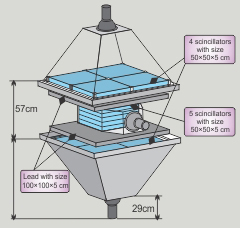SEVAN

Space Environmental Viewing and Analysis Network (SEVAN), is a worldwide network of identical particle detectors located at middle and low latitudes aimed to improve fundamental research of space weather conditions and to provide short- and long-term forecasts of the dangerous consequences of space storms. SEVAN detected changing fluxes of different species of secondary cosmic rays at different altitudes and latitudes, thus turning particle detector network into a powerful integrated device used to explore solar modulation effects. Till to now the SEVAN modules are installed at Aragats Space Environmental Centre in Armenia (3 units at altitudes 800, 2000 and 3200 m a.s.l.), Bulgaria (Moussala), Croatia and India (New-Delhi Univ.) and now started operation at Lomnitsky Schtit (Institute of Experimental Physics of Slovak Academy of Sciences, Kosice, Slovakia).
SEVAN network provides following advantages upon existing detector networks measuring single species of secondary Cosmic rays:
• Probe different populations of primary cosmic rays with rigidities from 7 GV up to 20-30 GV;
• Reconstruct Solar Cosmic Ray spectra and determine position of the spectral “knees”;
• Classify Ground level Enhancements in “neutron” or “proton” initiated events;
• Estimate and analyze correlation matrices among different fluxes;
• Significantly enlarge the reliability of Space Weather alerts due to detection of 3 particle fluxes instead of only one in existing neutron monitor and muon telescope world-wide networks.
Recently SEVAN detectors were used for research of new high-energy phenomena originated in terrestrial atmosphere – Thunderstorm Ground Enhancements (TGEs).
